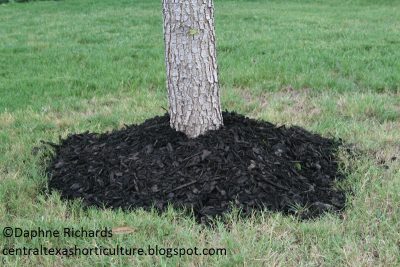How Not to Kill Your Trees Pt. 2

Here are maintenance tips to help you not kill your trees!
- Don’t prune too late or too much. Training trees is like bringing up pets and children. If you planted the right tree in the right place, little pruning will be needed. It is always best to do corrective work early in the tree’s life to avoid making large cuts later.
- Learn to prune correctly before you make the cuts. Don’t make cuts flush with the trunk. A proper cut will allow the branch collar to grow over the cut area and seal it up. Wounds that fail to close properly can affect the health of a tree. Cut damaged or rubbing limbs promptly and never top your trees. Have a reason for pruning a branch; don’t cut simply because you think it is time to do so.
- Don’t water too much or not enough. New trees will need water 2 to 3 times a week in the hot summer months if there is no rain, and weekly during the rest of the year. Use small sprinklers with a low water height. Start with an hour of watering and measure the soil moisture 5 inches deep 24 hours later. Use a long trowel to dig and inspect the soil moisture level. If it is still dry, increase the watering time. Soaking wet? Cut back on the time. Enough water for the lawn around a tree is seldom enough for the tree’s needs. You can use tree bags or just drill holes in 5 gallon buckets and place them around the tree to slowly soak the root zone.
- Don’t allow grass to grow up to the base of the tree. This disease is known as “weedeateritis”! Not only can a string trimmer damage the bark of the tree, opening the way for disease and insects, grass competes with the trees for moisture and nutrients. Leave a wide berm around your trees to avoid any contact with the mower or trimmer. This is especially important for fruit trees, young trees, and soft trunk trees like crepe myrtles.
- Don’t install raised bed gardens around the trunks of the trees. Most of the roots are in the top 12 to 18 inches and the increased moisture, compaction and lack of air flow will decay the trunk and eventually kill the tree. It may take several years for the damage to appear, so no one ever thinks the raised bed actually caused the damage. Build a raised bed and plant a tree in it, but don’t raise the soil height more than 2 inches around an existing tree.
- Don’t park your trees under a tree. Compaction of the soil reduces water and air flow. Again, it may be years before you see the damage but it can kill your trees.
- Don’t let vines like Asian jasmine and English ivy grow up to the trunk and into the canopy. Ivy keeps moisture around the trunk of the tree, and its roots actually grow into the bark. Cut ivy and allow it to dry well before you pull it off to avoid removing much of the bark. Asian jasmine can girdle a tree and cut off nutrient flow to the tree. Keep these plants 15-24 inches away from tree trunks.
- Don’t leave girdling roots. These can kill a tree slowly. Avoid buying trees with girdled roots.
- Mulch but don’t add too much. Ideally we would leave all of the fallen leaves to provide nutrients and act as mulch for the trees. Mulch can pack tightly and actually shed water so stir the mulch up under your trees and shrubs occasionally. Never apply mulch around the trunk of the tree. Leave space for it to breathe and dry out. Instead, create a mulch berm (again, to avoid contact with mowers and trimmers) and to hold in rainfall. Lightly mulch inside the berm but avoid mulching against the trunk.
- Don’t volcano mulch! On the other end of the spectrum is the mulch volcano, often seen in commercial landscapes. Like planting a raised bed around the trunk, this excessive mulch will hold too much moisture around the trunk and prevent water and nutrient flow to the roots.
- Don’t use herbicides and weed and feed products around the base of your trees. The best time to kill most lawn weeds and the time to fertilize lawns do not coincide. Herbicide drift and spray used in the root zone of trees can weaken trees.
categories:
tags:
related:
appeared on episodes:

 Trisha Shirey
Trisha Shirey